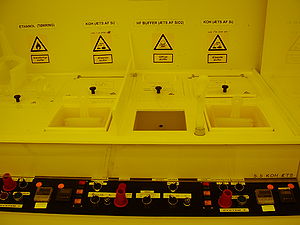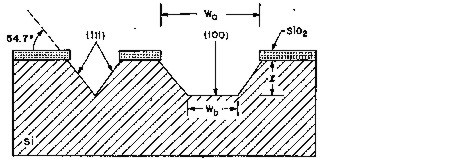Specific Process Knowledge/Etch/KOH Etch: Difference between revisions
| Line 97: | Line 97: | ||
Due to the almost inert (111)-planes..... | Due to the almost inert (111)-planes..... | ||
[[Image:KOH_Anisotropy.jpg]] | |||
<br clear="all" /> | <br clear="all" /> | ||
Revision as of 16:04, 27 February 2008
KOH etch - Anisotropic silicon etch

KOH belongs to the family of anisotropic Si-etchants based on aqueous alkaline solutions. The anisotropy stems from the different etch rates in different crystal directions. The {111}-planes are almost inert whereas the etch rates of e.g. {100}- and {110}-planes are several orders of magnitude faster.
KOH-etching is a highly versatile and cheap way to realize micro mechanical structures if you can live with the necessary SiN- or SiO-masking materials and the potassium contamination of the surface. The latter necessitates in most cases a wet post-clean ('7-up' or RCA-clean) if the wafer is to be processed further.
At Danchip we use as a standard a 28 wt% KOH. The etch rate - and the selectivity towards a SiO-mask - is depending on the temperature. We normally use T=80 oC but may choose to reduce this to e.g. 60 oC or 70 oC in case of a high-precision timed etch (e.g. defining a thin membrane). In some cases we recommend to saturate the standard 28 wt% KOH with IPA with an etch temperature at T=70 oC (reduce evaporation of IPA). One example is for boron etch-stop, where the selectivity towards the boron-doped silicon is improved compared to the standard etch. Key facts for the two solutions are resumed in the table:
KOH solutions
| 28 wt% KOH | 28 wt% KOH sat. with IPA | |
|---|---|---|
| General description |
|
|
| Chemical solution |
|
|
| Process temperature |
|
|
| Possible masking materials |
|
|
| Etch rate |
|
|
| Roughness |
|
|
| Batch size |
|
|
| Size of substrate |
|
|
| Allowed materials |
|
|
Definition of structures
Due to the almost inert (111)-planes.....
Definition of <110> alignment structures
The etch rate dependence on the crystallographic planes can be used to determine the <110> crystal directions with high precision (better than +/- 0.05 o). A fast method for doing this, using the symmetric under-etching behavior around but not at the <110>-directions, was described by Vangbo and Bäcklund in J. Micromech. Microeng.6 (1996), 279-284. High-precision control of the <110>-direction during alignment can be necessary in order to control the dimensions of KOH-etched structures (e.g. precise control of V-groove dimensions). A dedicated mask (MASK NAME) has been designed for this purpose.
Etch rates: Empirical formula (Seidl et al)
The following empirical formula can be used for concentrations in the range of 10-60 wt%:
R = k0 [H2O]4 [KOH]0.25 e-Ea/kT,
where k0 = 2480 µm/hr (mol/l)-4.25, Ea = 0.595 eV for Si(100)
and k0 = 4500 µm/hr (mol/l)-4.25, Ea = 0.60 eV for Si(110)




